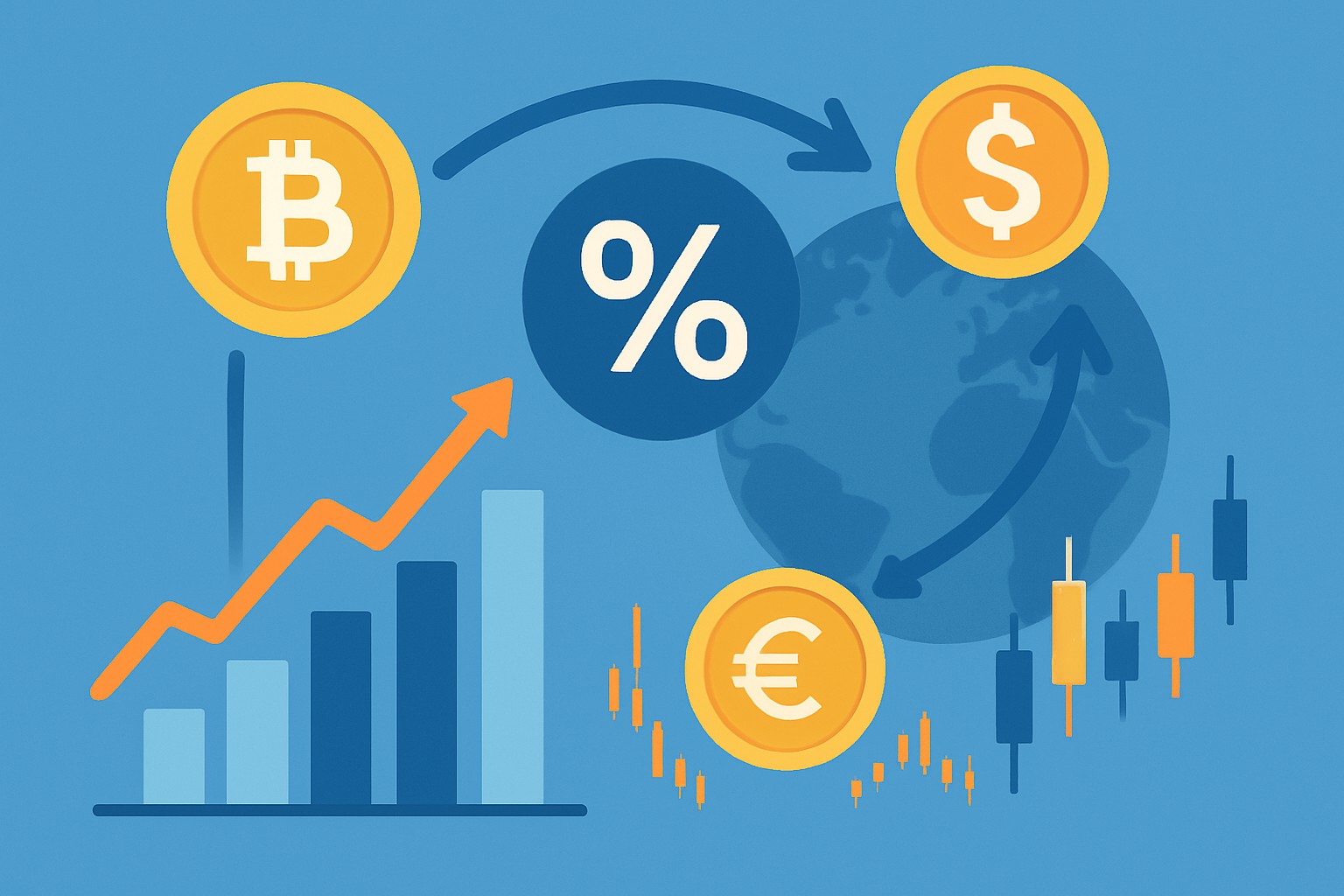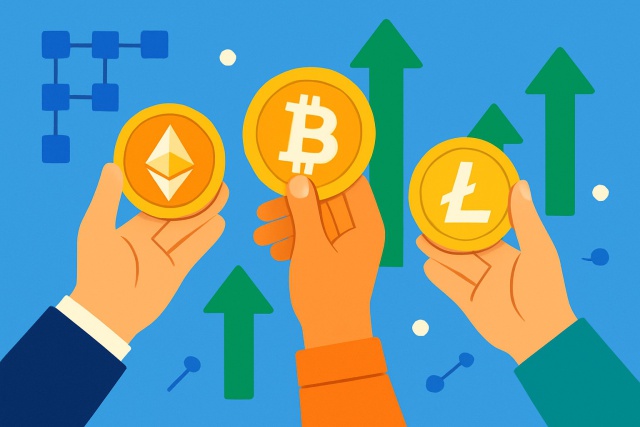What Is The Carry Trade and How It Works?


The carry trade is a classic financial strategy where investors borrow money in a currency with low interest rates and then plow those funds into assets promising higher returns.
What Does Carry Trade Really Mean
Carry trade is a clever little strategy where investors borrow money at a low interest rate in one currency, then take that cash and park it in another currency or asset that offers a juicier interest rate.
- Carry trade is basically about profiting from the difference in interest rates between two currencies or assets. It’s like borrowing money at a low cost and putting it to work where it yields more.
- The real advantage behind potential gains in carry trade usually comes down to interest rate differences.
- The usual players in this game are forex traders, hedge funds and banks. Recently, crypto investors have joined in.
- Carry trade works because borrowers pay lower interest than the returns they earn from lending or investing. It sounds simple but the details are important.
- A common mistake is thinking carry trade profits come without risk or are guaranteed. If it were that easy, everyone would be doing it without hesitation.
Carry Trade Explained Step by Step
A carry trade involves borrowing money in a currency with low interest rates and swapping it into a currency or asset that promises higher returns. You collect interest on that investment and when the time feels right, close the position to lock in your gains or losses.
Borrow money in a currency that usually comes with a lower interest rate, often referred to as the funding currency.
Swap those borrowed funds into a currency or asset that offers a higher interest yield, aiming to make your money work a bit harder.
Put the converted cash to good use by investing or lending it, all in an effort to pocket the difference in interest rates.
Keep a vigilant eye on exchange rates and market swings, because currency fluctuations can throw a wrench in even the best-laid plans.
Wrap up the trade by paying back what you borrowed and locking in whatever net profit or loss comes your way.
Key terms like interest rate parity guide you when trying to understand why carry trades can turn risky once exchange rates change. Leverage increases both the highs and lows, sometimes giving you a thrill and other times a headache. Currency pairs such as USD/JPY show the two players in the trade arena.
Understanding Carry Trade within Cryptocurrencies A Closer Look at How It Works and Why It Matters
Carry trade ideas tend to pop up in spots like stablecoin lending and yield farming or lending platforms where you can capitalize on shifting interest rates. Sure, the volatility of crypto adds a bit of a twist to the story.
- Stablecoins usually offer steady currencies with interest rates that vary depending on the platform making them a go-to choice for carry trade strategies.
- DeFi lending protocols allow users to borrow and lend at different rates which often sets the stage for classic carry trade scenarios.
- Yield farming is a form of carry trade as it combines token rewards with interest rate differences, a double whammy if you will.
- Margin trading and leverage on crypto exchanges can amplify carry trade opportunities but it also increases the risk factor.
- When it comes to crypto-specific risks you can’t ignore the wild swings in price, worries about platform security, and buzz around regulatory uncertainty.

Risks and Challenges Associated with Carry Trade You Need to Watch Out For
Carry trade comes with its fair share of risks like exchange rate swings and shifts in interest rates. Liquidity hiccups and leverage can really crank things up a notch. In the crypto world these risks don’t just knock politely—they tend to hit harder because the market is still finding its footing and the rules of the game keep changing.
- Exchange rate risk can seriously eat away at your expected profits or even wipe them out entirely if the currencies swing the wrong way.
- Changes in interest rates might sneak up and change how profitable a trade ends up being over time.
- Leverage doesn’t just boost your gains; it also cranks up your losses and turns up the risk dial.
- Counterparty or platform risk is a big issue in DeFi because a bug or hack can throw a wrench in everything.
- Regulatory uncertainty around cryptocurrencies often suddenly cuts off access or flips the rules when you least expect it.
The carry trade can offer attractive returns thanks to interest rate differences, but it’s not all sunshine and rainbows. It carries some pretty significant risks that demand careful risk management and a keen eye on market changes—otherwise, you might find yourself staring down some major losses.
Some Real-World Glimpses of the Carry Trade in Action
One classic move in traditional finance is to borrow Japanese yen at rock-bottom interest rates—basically near zero—and then put that money to work in assets that pay better yields like the Australian dollar. The goal is to pocket the interest difference. Over in the crypto space the play is similar. Investors often borrow stablecoins at around 2% interest and then lend them out on platforms that offer closer to 8%.
| Currency Borrowed | Currency/Asset Invested In | Interest Rate Differential | Duration | Outcome |
|---|---|---|---|---|
| Japanese Yen (JPY) | Australian Dollar (AUD) | About 2.5% | 6 Months | Steady, moderate gains in a market that stayed fairly stable |
| USD Stablecoin | ETH Lending Platform | Around 6% | 3 Months | Attractive returns, but watch out—volatility can sneak up unexpectedly |
| Euro (EUR) | Emerging Market Bonds | Roughly 3% | 1 Year | Ended up with losses thanks to those pesky rising interest rates |
| BTC Margin Trade | BTC | Varies | 1 Month | Could swing either way—big profits or big losses, so buckle up |
| USDT Borrowing | DeFi Yield Farming | Over 4% | Flexible | Returns fluctuate quite a bit depending on platform risks, so it’s a bit of a mixed bag |
These examples really show how important timing, market conditions and platform reliability can be. Carry trades usually offer steady income but a sudden market move or an unexpected interest rate tweak can flip those gains upside down faster than you would think.
Getting the Hang of Carry Trade in Crypto
Beginners diving into carry trade in the crypto world should tread carefully when picking platforms. Aim for stablecoins or tokens that boast attractive interest rate gaps and keep a sharp eye on any fees lurking beneath the surface.
Begin by digging into your options between centralized exchanges that offer lending and decentralized DeFi platforms. Weigh factors like trustworthiness and security because not all platforms are created equal.
Choose stablecoins or crypto assets where the borrowing cost usually plays nice compared to the lending or yield interest rate. It’s kind of like finding a sweet spot that keeps your wallet happy.
Take a close look at all the fees involved, from withdrawal charges to how often interest compounds plus any sneaky transaction costs the platform might throw your way.
Tread carefully with leverage: start small to avoid waking up to a wallet that’s taken a bigger hit than you bargained for.
Keep a vigilant eye on your positions—markets can be slippery so be ready to close trades if things start going south unexpectedly.
Widespread Myths and Misunderstandings About Carry Trade
Many people assume that the carry trade hands out guaranteed, risk-free profits on a silver platter or that it’s strictly a playground for big-shot investors. These notions really gloss over the nitty-gritty and tend to downplay the real risks lurking beneath, like market volatility and the tricky business of leverage.
- The idea that carry trade comes with zero risk is a bit of a stretch since exchange rate fluctuations can cause losses.
- Believing it’s all smooth sailing with steady profits ignores when market conditions disrupt the interest rate advantage.
- Crypto carry trade often gets compared to forex but tends to ride a more volatile rollercoaster and carries extra platform risks.
- Sure, leverage can boost your profits but it’s no magic wand—losses can ramp up just as fast if not faster.
- On the bright side, small investors can often jump in effectively especially within DeFi spaces where minimum investment bars are usually low.
Start Your Crypto Journey with Coinbase Today
Ready to enter the cryptocurrency market but unsure where to begin? Coinbase makes buying, selling, and storing digital assets simple and secure for beginners and experts alike.








